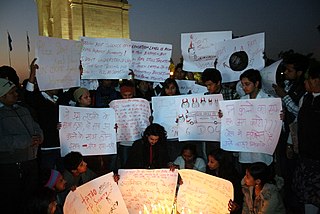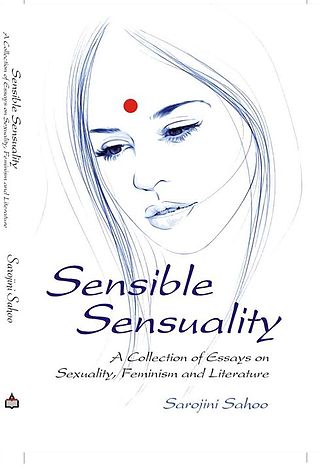Related Research Articles

Sex-selective abortion is the practice of terminating a pregnancy based upon the predicted sex of the infant. The selective abortion of female fetuses is most common where male children are valued over female children, especially in parts of East Asia and South Asia, as well as in the Caucasus, Western Balkans, and to a lesser extent North America. Based on the third National Family and Health Survey, results showed that if both partners, mother and father, or just the father, preferred male children, sex-selective abortion was more common. In cases where only the mother prefers sons, this is likely to result in sex-selective neglect in which the child is not likely to survive past infancy.
A dowry is a payment, such as property or money, paid by the bride's family to the groom or his family at the time of marriage. Dowry contrasts with the related concepts of bride price and dower. While bride price or bride service is a payment by the groom, or his family, to the bride, or her family, dowry is the wealth transferred from the bride, or her family, to the groom, or his family. Similarly, dower is the property settled on the bride herself, by the groom at the time of marriage, and which remains under her ownership and control.
Female infanticide is the deliberate killing of newborn female children. Female infanticide is prevalent in several nations such as China, India and Pakistan. It has been argued that the low status in which women are viewed in patriarchal societies creates a bias against females. The modern practice of gender-selective abortion is also used to regulate gender ratios.
Hindu views of homosexuality and LGBT issues more generally are diverse, and different Hindu groups have distinct views.

The status of women in India has been subject to many changes over the time of recorded India's history. Their position in society deteriorated early in India's ancient period, especially in the Indo-Aryan speaking regions, and their subordination continued to be reified well into India's early modern period.

Femicide or feminicide is a term for the hate crime of systematically killing women, girls, or females in general because of their sex. In 1976, the feminist author Diana E. H. Russell first implicitly defined the term as a hate killing of females by males but then went on to redefine it as "the killing of females by males because they are female" in later years. Femicide can be perpetrated by either gender but is more often committed by men. This is most likely due to unequal power between men and women as well as harmful gender roles, stereotypes, or social norms.
Bride burning is a form of domestic violence practiced in countries located on or around the Indian subcontinent. A form of dowry death, bride-burning occurs when a woman is murdered by her husband or his family for her family's refusal to pay additional dowry. The wife is typically doused with kerosene, gasoline, or other flammable liquid, and set alight, leading to death by burning. Kerosene is often used as the cooking fuel for small petrol stoves, some of which are dangerous, so it allows the claim that the crime was an accident. It is most common in India and has been a major problem there since at least 1993.
Gendercide is the systematic killing of members of a specific gender. The term is related to the general concepts of assault and murder against victims due to their gender, with violence against men and women being problems dealt with by human rights efforts. Gendercide shares similarities with the term 'genocide' in inflicting mass murders; however, gendercide targets solely one gender, being men or women. Politico-military frameworks have historically inflicted militant-governed divisions between femicide and androcide; gender-selective policies increase violence on gendered populations due to their socioeconomic significance. Certain cultural and religious sentiments have also contributed to multiple instances of gendercide across the globe.

Androcide is a term for the hate crime of systematically killing men, boys, or males in general because of their gender. Not all murders of men are androcides in the same way that not all murders of women are femicides. Androcides often happen during war or genocide. Men and boys are not solely targeted because of abstract or ideological hatred. Rather, male civilians are often targeted during warfare as a way to remove those considered to be potential combatants, and during genocide as a way to destroy the entire community.

Sarojini Sahoo is an Indian feminist writer, a columnist in The New Indian Express and an associate editor of Chennai-based English magazine Indian AGE. She has been enlisted among 25 Exceptional Women of India by Kindle Magazine of Kolkata. and is an Odisha Sahitya Academy Award winner.

Feminism in India is a set of movements aimed at defining, establishing, and defending equal political, economic, and social rights and opportunities for women in India. It is the pursuit of women's rights within the society of India. Like their feminist counterparts all over the world, feminists in India seek gender equality: the right to work for equality in wages, the right to equal access to health and education, and equal political rights. Indian feminists also have fought against culture-specific issues within India's patriarchal society, such as inheritance laws.
Gender inequality in India refers to health, education, economic and political inequalities between men and women in India. Various international gender inequality indices rank India differently on each of these factors, as well as on a composite basis, and these indices are controversial.
Feminist views on BDSM vary widely from acceptance to rejection. BDSM refers to bondage and discipline, dominance and submission, and Sado-Masochism. In order to evaluate its perception, two polarizing frameworks are compared. Some feminists, such as Gayle Rubin and Patrick Califia, perceive BDSM as a valid form of expression of female sexuality, while other feminists, such as Andrea Dworkin and Susan Griffin, have stated that they regard BDSM as a form of woman-hating violence. Some lesbian feminists practice BDSM and regard it as part of their sexual identity.
Female foeticide in India is the abortion of a female foetus outside of legal methods. A research by Pew Research Center based on Union government data indicates foeticide of at least 9 million females in the years 2000–2019. The research found that 86.7% of these foeticides were by Hindus, followed by Sikhs with 4.9%, and Muslims with 6.6%. The research also indicated an overall decline in preference for sons in the time period.

Sensible and Sensuality is a collection of essay by Indian feminist writer Sarojini Sahoo. Published in 2010, the book contains the author's view on feminism. Sahoo is a key figure and trend-setter of feminism in contemporary Indian literature. She has been listed among 25 exceptional women of India by Kindle English magazine of Kolkata. For Sahoo, feminism is not a "gender problem" or confrontational attack on male hegemony and, as such, differs from the feminist views of Virginia Woolf or Judith Butler.
It's a Girl: The Three Deadliest Words in the World is a 2012 documentary film which explores the practice of female infanticide. It was directed by Evan Grae Davis and focused primarily on India and China. The United Nations has estimated that up to 200 million females are "missing" today, most of whom would have lived in India and China. The film took four years to shoot.
China has a history of female infanticide which spans 2,000 years. When Christian missionaries arrived in China in the late sixteenth century, they witnessed newborns being thrown into rivers or onto rubbish piles. In the seventeenth century Matteo Ricci documented that the practice occurred in several of China's provinces and said that the primary reason for the practice was poverty. The practice continued into the 19th century and declined precipitously during the Communist era, but has reemerged as an issue since the introduction of the one-child policy in the early 1980s. The 2020 census showed a male-to-female ratio of 105.07 to 100 for mainland China, a record low since the People's Republic of China began conducting censuses. Every year in China and India alone, there are close to two million instances of some form of female infanticide.
Female infanticide in India has a history spanning centuries. Poverty, the dowry system, births to unmarried women, deformed infants, famine, lack of support services, and maternal illnesses such as postpartum depression are among the causes that have been proposed to explain the phenomenon of female infanticide in India.

Violence against women in India refers to physical or sexual violence committed against a woman, typically by a man. Common forms of violence against women in India include acts such as domestic abuse, sexual assault, and murder. There are several forms of violence against women, murder, female infanticide, sexual crimes, acid throwing, perpetuation.
Doodh peeti was a method of female infanticide in which newborn girls were drowned in pails or pits of cow milk (doodh). It is the British government who found that in Rajasthan, the people were dipping and drowning newborn girls in milk until they died. The practice was prevalent in the Saurashtra and Kutch region of India. The phrase is a euphemism literally meaning "feeding of milk".
References
- ↑ Tooney, Nancy M. (July 1995). "AWIS Educational Foundation Awards". AWIS Magazine. 24 (4): 16. Archived from the original on 18 May 2015. Retrieved 7 May 2015.
- ↑ "Published works". Rita Banerji. 15 January 2010. Retrieved 8 May 2015.
- ↑ Husson Isozaki, Anna. "Review of Sex and Power". Intersections: Gender, History and Culture in the Asian Context. Australian National University. Retrieved 8 May 2015.
- 1 2 Sengupta, Anandita. "How we came to genocide". Tehelka. Anant Media Pvt. Ltd. Archived from the original on 18 May 2015. Retrieved 8 May 2015.
- ↑ Todhunter, Colin. "Where have they all gone?". Deccan Herald. The Printers (Mysore) Private Ltd. Archived from the original on 8 October 2014. Retrieved 8 May 2015.
- ↑ Banerji, Rita. "Why We Slept Through A Genocide-Part II". It's A Girl! Movie Blog. Retrieved 4 May 2012.
- ↑ Ciara Leeming (20–26 July 2009). "Author Q&A: Rita Banerji". The Big Issue in the North. Retrieved 4 May 2012.
- ↑ Rita Banerji (12 June 2011). "Why Education and Economics are not the Solution to India's Female Genocide". The Gender Bytes Blog. Retrieved 1 June 2012.
- ↑ Rita Banerji (22 February 2012). "Facebook Game 'Angry Brides' Trivializes Grave Human Rights Violations". The Women’s International Perspective (WIP). Retrieved 1 June 2012.
- ↑ Rita Banerji (19 May 2011). "Indian Girls "Missing" Worldwide". Pickled Politics. Archived from the original on 22 May 2011. Retrieved 1 June 2012.
- ↑ Rita Banerji (7 February 2012). "Girl Infants face pre-mediated murder under Femicide". Women’s News Network (WNN). Retrieved 1 June 2012.
- ↑ Rita Banerji (October 2009). "Female Genocide in India and The 50 Million Missing Campaign". Intersections: Gender and Sexuality in Asia and the Pacific, Issue 22. Retrieved 1 June 2012.
- ↑ Rita Banerji (January 2010). "The Pink Panties Campaign and the Indian Women's Sexual Revolution". Gender and Sexuality in Asia and the Pacific, Issue 23. Retrieved 1 June 2012.
- ↑ Rita Banerji (2012). "Why Kali Won't Rage: A Critique of Indian Feminism". Gender Forum, Issue 38. Retrieved 30 June 2012.
- ↑ Rita Banerji (2 September 2011). "Slutwalk to Femicide: Making the Connection". The Women’s International Perspective (WIP). Retrieved 1 June 2012.